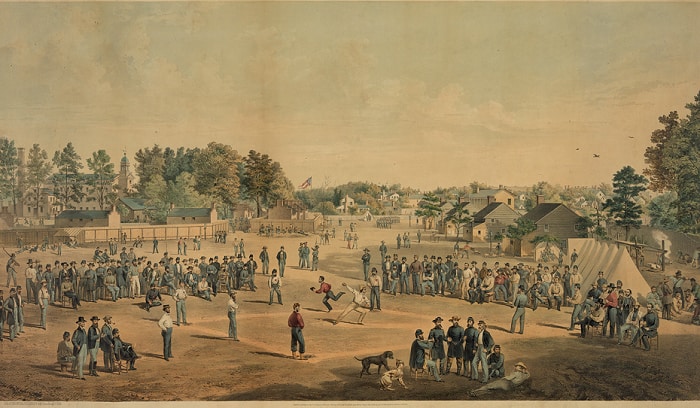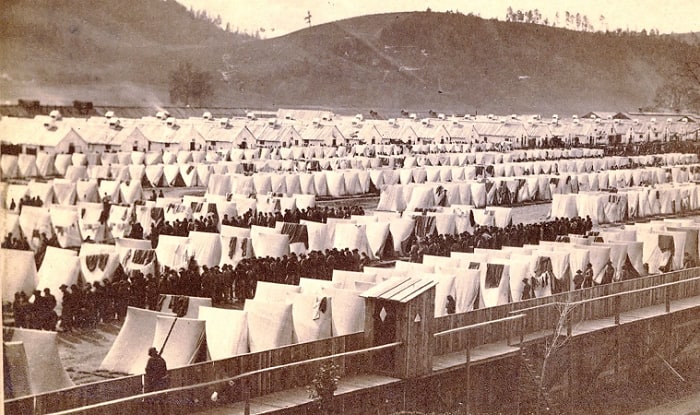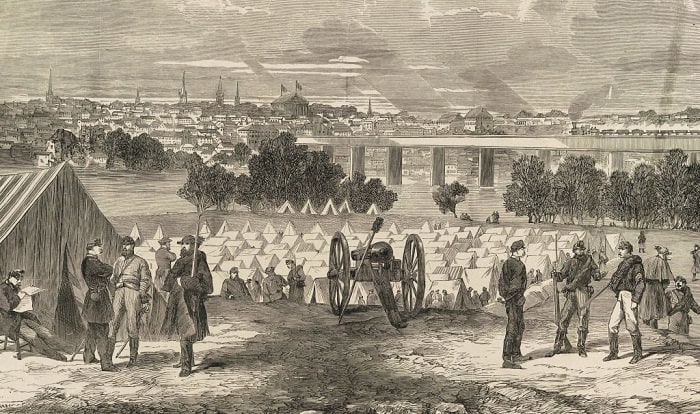Why were military prisons during the Civil War not constructed very well? The primary reason was that neither the Union nor the Confederate expected the war to last long. As such, they were not prepared to confine prisoners for a long time.
We will explain this in more detail below and provide other relevant information.
So, continue to read everything thoroughly!
Table of Contents
Why Were Civil War Military Prisons Not Constructed Very Well?
When the war broke out, neither side expected it to last long. By the same token, no one was prepared for the long-term confinement of prisoners.
Captured soldiers in the first 2 years of the war were initially meant to face battlefield paroles that would return them to their lines in a few weeks.
In 1862, a formalized system was created for exchanging soldiers of equal ranks. However, confusion and accusations regarding the number of “equal” exchanges followed instantly.
In 1864, when black soldiers joined the Union Army, the system was challenged. Those on the Confederate side refused to exchange black soldiers for white soldiers, while the Union’s side would only change black soldiers and white soldiers as equals.
A related topic to the entrance of black soldiers into the Army was the Enrollment Act of Conscription, which caused the New York city riots in 1863.
As both sides stood their ground, they had to hold hundreds (later thousands) of soldiers as prisoners. But because they did not originally expect to do so, they struggled to construct prisons well.
Civil War Camps/ Prisons
There had been roughly 400.000 men imprisoned by the war’s end. Although not every experience behind bars was the same, most suffered from harsh living conditions, sadistic treatment, and disease outbreaks.
Military Camps/ Prisons in the North
Many prisons were made from existing military fortifications, such as Fort Delaware and Fort Monroe. In addition, some prisons were shaped from existing fairgrounds, training grounds, and racetracks.
Military Camps/ Prisons in the South
Many warehouses and open fields were converted into prisons. Even islands were used as prisons. The key focus for military prisons in the South was centralizing prisoner populations in a few large prisons.
Frequently Asked Questions
How were military prisoners treated during the Civil War?
When captured, prisoners would be taken to the rear under guard, where they would be transported to a train depot and moved to the nearest prison.
Some could spend days on a train, depending on how close they were to a prison.
When they arrived, the prisoners would be counted and placed behind bars. During this, they would also be mercilessly looted by the guards.
What problems did captured soldiers face during the Civil War?
What were the conditions of prisons during the Civil War?
Inside a prison, prisoners had to make do with hazards like overcrowding, contaminated drinking water, and diseases, including diarrhea, gangrene, and smallpox. The daily life of a Civil War prisoner was often horrific.
This happened because supplies were prioritized for the front lines, not prisons.
Under the hell-like conditions, it was no surprise that prisoners tried to escape. But in most cases, those who attempted to do so were recaptured and faced severe punishments.
Civilians in both the North and South tried to help prisoners as much as possible. Many tried to sneak in food and clothes for the prisoners. Slave populations were also well-known for helping soldiers get access to food and/or escape. However, those who were caught aiding prisoners had to face serious charges.
It was estimated that by the end of the war, up to 56,000 soldiers had died in captivity. These men fought for their lives not only on the battlefield but also behind bars.
How are military prisons different?
The main difference between military prisons and civilian prisons was the condition of the facility. Most military prisons, particularly in wartime, are broken, rundown, and unsanitary.
During the war, there were over 250 prisons established. Here are eight well-known ones:
- Salisbury Prison
This was a Confederate prison in North Carolina. It was converted from a cotton mill in 1861. At the start, the conditions in prison were passable. Captives had adequate rations and were even allowed to pass the time with recreational games like baseball.
But this changed drastically as the war progressed. The number of captives soared from 120 to 5,000 and then to over 10,000. More men meant overcrowding, food shortages, and decreased sanitation. So death, starvation, filth, and disease loomed over the course of the war.
Interesting Fact – In 1861, when the prison population was still low, the death rate was only two percent. Four years later, it skyrocketed to more than 28 percent.
- Point Lookout
This was a prison in Maryland for Confederate prisoners of war. Since it was close to the Eastern Theater, overcrowding quickly became an issue. At one point, there were more than 20,000 captives in prison. By the time the war ended, over 52,000 had passed through it.
It was estimated that at least 4,000 succumbed to illnesses as a result of overcrowding, soiled water, and poor sanitation.
- Elmira Prison
This prison in New York is also known as “Hellmira.” It was opened in 1864 and quickly became notorious for its unbearable living conditions and staggering death rate.
The culprit was the Commissary General of Prisoners: Colonel William Hoffman.
He gave prisoners no shelter and made prisoners sleep outside in the open. The captives had to count on their own ingenuity for shelters with logs, sticks, and blankets. In the winter, they were shivering and in the summer, they were sweltering.
Another problem was overcrowding. Despite having a ceiling of 4,000 prisoners, just one month into its opening, the prison held more than 12,000 soldiers. By September 1865, up to 3,000 had died. The death rate was 25%, and Elmira was deemed one of the deadliest prisons throughout the war.
- Camp Douglas
This was a prison camp in Illinois, also referred to as the “Andersonville of the North.” It was shaped out of a training facility for Illinois regiments.
More than 18,000 Confederate soldiers were captured during the Civil War and incarcerated here by the time the war ended. Statistically speaking, one in seven prisoners died for a total of 4,200 by 1865.
Union camp leaders cut ration sizes and quality for their personal profit, leading to scurvy, illnesses, and starvation.
According to a past U.S Sanitary Commission report, the soil reeked of accreditations and rotten bones, the sinks were foul, and the barracks were incredibly infested and filthy. The conditions were enough to drive people mad.
- Belle Isle
This was a prison on an island within the James River in Virginia. It held many Northern politicians and poets. It operated from 1862 to 1965 and was packed with over 30,000 men.
The prisoners had to construct their own shelters and the lack of them drove the death toll up to 15,000. A quote from former U.S Treasurer Lucious Eugene Chittenden describes the conditions at Belle Isle:
- Florence Stockade
This prison camp was established in response to the scattering of Union soldiers at Andersonville Prison in Georgia.
Despite operating for only five months, from September 1864 to February 1865, the prison processed up to 18,000 Union soldiers. It was estimated that by the war’s end, one in three prisoners at Florence died.
Like other prisons, the death toll was supported by a lack of shelter and food and poor sanitation.
- Andersonville
This prison in Georgia was also known as Camp Sumter. It operated for 14 months and in this short time, received 45,000 prisoners and killed 13,000. There were limited rations and a high frequency of scurvy. It was also problematic that prisoners formed gangs to beat or murder other men for supplies and food.
Andersonville was considered the deadliest prison in the Civil War, though its contributing factors were shared by prisons on both sides.
Conclusion
Now, you should know how to answer, “Why were military prisons during the Civil War not constructed very well?” Apart from the “why,” you also know a bit of the “what.” The conditions were rather poor and many problems existed, such as overcrowding, lack of clean water, food, shelter, etc. Hopefully, our article has been informative and interesting. Leave your thoughts and questions in the comments below and help us share this with other readers!
Read more:
- A person who was the main military commander for southern forces during the civil war.
- Military action that started the american civil war.

I am Everett Bledsoe, taking on the responsibility of content producer for The Soldiers Project. My purpose in this project is to give honest reviews on the gear utilized and tested over time. Of course, you cannot go wrong when checking out our package of information and guide, too, as they come from reliable sources and years of experience.



